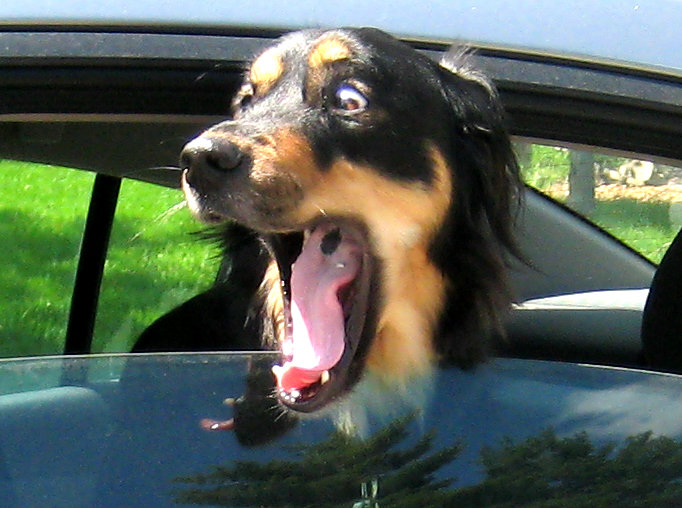Definition
Heat stroke is an elevation of the body temperature caused by excessive exposure to heat and the inability of the body to dissipate the heat to regulate body temperature. The normal temperature of a dog is between 38.5 to 39.5C. We call it heat stroke when the body temperature is higher than 40 degrees Celsius or 104 degrees Fahrenheit.
Heat stroke is an emergency. The condition can be fatal if not treated immediately.
Cause
This condition typically happens in the spring or summer time during hot days. Heat stroke can happen after strenuous exercise, if the dog is confined in a poorly ventilated small space, when left outside without shade and fresh water on a concrete or asphalt surface, or if left in a car on a hot day, even for a minute. Other causes include seizure, infection, drug reaction, etc.
Predisposition

Every dog, every breed, can suffer from heat stroke, even an athletic dog. However, brachycephalic breeds (those with short snouts) such as Bulldogs, Boston Terriers, Pugs, Shih Tzus are more at risk . Dogs with thick coats or black hair such as Chow Chows, Newfoundlanders, Bernese mountain dogs are also at risk. Older dogs, overweight dogs and those with illness (respiratory disease, heart disease, neurologic disease) are also in the high risk category.
Clinical signs to watch for
- Heavy panting.
- Difficulty breathing.
- Loud upper airway sounds.
- Tongue and mucous membranes may be more red (hyperemic).
- Vomiting, diarrhea.
- Dehydration, shock (tacky or dry gums, thick saliva and prolonged skin fold).
- Excessive drooling.
- Tachycardia (higher heart rhythm).
- Inability to rise, altered mental status (dizziness or disorientation).
- Grey membranes before collapse, seizure, tremors, coma and death.
- Body temperature higher than 40 degrees Celsius or 104 degrees Fahrenheit.
Treatment
-
Remove the animal from the heat source or out of the sun.
- Put the pet in a calm, quiet room. Do not stimulate him. Avoid stress.
- Initiate cooling measures as soon as possible. Spray the dog with cool (not cold) water. Place a wet cloth on the head, neck, belly and the feet. Replace the cloths often so they stay cool. Do not cover the entire body, as this can actually trap heat around the body of the dog. The use of very cold water and ice is contraindicated. It is important not to cool the dog too quickly or too much. The goal is to bring the pet’s temperature to 39- 39.4C (102-103 degrees Fahrenheit) over a period of 15 to 20 minutes. A fan may also be used to cool the dog down.
- Seek emergency veterinary care immediately. Keep the air conditioning running while driving if possible, or open the windows. A physical exam is necessary even if the dog looks better. There may be some internal damage that is not immediately evident. The treatment will be determined and the extent of the damage assessed after a complete physical exam and some emergency tests and treatments such as oxygen supplement, IV fluids, blood testing, electrocardiogram, antibiotics, gastro-intestinal protectants, anti-emetics. A 48-hour hospitalization may be required to make sure there are no complications.
Consequence and prognosis
Heatstroke affects and has the potential to damage multiple organs in the body such as the brain, the heart, the vascularization, the respiratory system, the digestive system, the coagulation system that controls bleeding. It is a life-threatening condition with a risk of death within 24 hours after development of symptoms if no treatment is administered. Prompt and early recognition of this condition can make a big difference in saving a dog’s life. The recovery and prognosis will depend on how fast the cooling procedure was done after the first signs of heat stroke and how advanced the condition. Studies have shown that early cooling procedures done by the owner before consulting the veterinarian can significantly lower the mortality rate! Dogs can make a full recovery if caught on time, but in more severe cases, permanent brain, liver, and renal failure can occur.
Prevention
- Minimize exercise during the hottest part of the day or during a heat wave. Favour morning and evening walks. Do not forget to bring water along for the walks.
- When you travel by car with your pet allow for frequent stops to rest and have a drink of water.

- Never leave your dog in the car even for a minute, and regardless whether the windows are open or parked in a shaded zone. On a hot day of 25 degrees Celsius the temperature inside the car can climb to 48 Celsius ! On a 32C day the temperature can rise up to 71C in 10 minutes. The inside of your car is like an oven.
- Avoid leaving your dog on a concrete or asphalt surface on a hot day. The ground temperature can reach up 45C and sometimes 50C! As well as heat stroke, a hot surface can cause severe foot pad burns. This can be even more serious in small breeds who are very low to the ground. They can be more affected by heat radiating from the pavement. Keep small breeds in your arms, if possible.
- Make sure your dog has fresh water available at all times and access to a well-ventilated room. Ice in the water bowl can be refreshing as well. Favour a shaded, cool outdoor area if you are planning an outdoor activity with your dog. Air conditioning or a fan indoors on the hottest days of the summer is recommended.
- If you see an unattended pet in a car on a hot, sunny day please try to reach the owner. If it is impossible to reach the owner, it may be necessary to call the police. You may save the pet’s life!
